NRSG258 Acute Care: A Case Study on Post-Hysterectomy Deterioration
VerifiedAdded on 2023/06/07
|10
|2650
|152
Case Study
AI Summary
This case study analyzes the condition of Cynthia Jones, a 49-year-old woman recovering from a total abdominal hysterectomy, complicated by post-operative deterioration including increased respiratory rate and low blood pressure. The essay discusses the etiology and pathophysiology of uterine fibroids, the underlying condition leading to the surgery, and addresses the management of post-operative complications. Priorities of care are outlined, including oxygen administration and electrolyte balance. The study recommends involving a psychotherapist, community service helper, and pharmacist as part of an interdisciplinary team to support the patient's physical and emotional recovery, especially considering her history of mild depression and recent loss. The goal is to ensure a smooth transition post-discharge and manage her daily living activities effectively.

Running head: CASE STUDY ANALYSIS
CASE STUDY ANALYSIS
Name of the Student:
Name of the University:
Author Note:
CASE STUDY ANALYSIS
Name of the Student:
Name of the University:
Author Note:
Paraphrase This Document
Need a fresh take? Get an instant paraphrase of this document with our AI Paraphraser
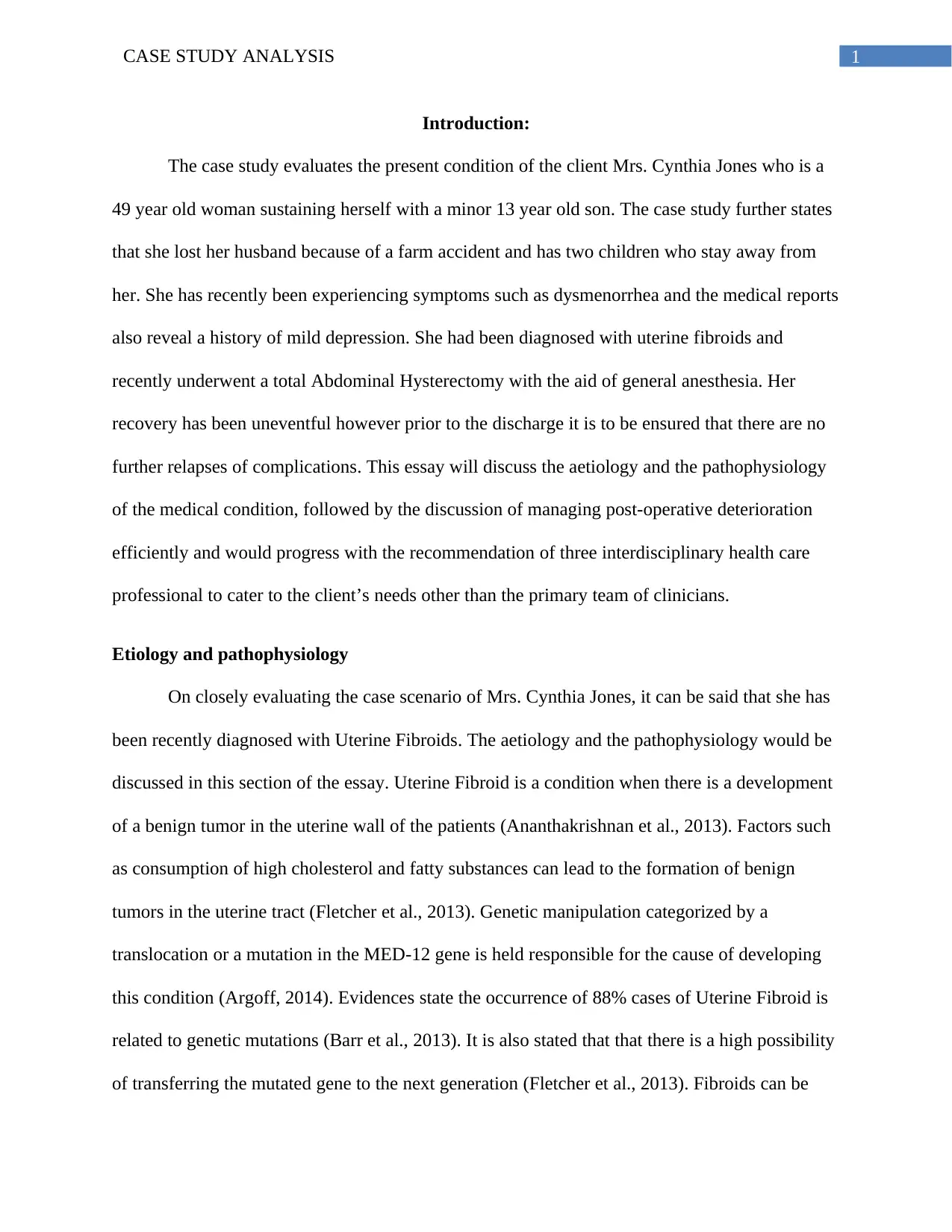
1CASE STUDY ANALYSIS
Introduction:
The case study evaluates the present condition of the client Mrs. Cynthia Jones who is a
49 year old woman sustaining herself with a minor 13 year old son. The case study further states
that she lost her husband because of a farm accident and has two children who stay away from
her. She has recently been experiencing symptoms such as dysmenorrhea and the medical reports
also reveal a history of mild depression. She had been diagnosed with uterine fibroids and
recently underwent a total Abdominal Hysterectomy with the aid of general anesthesia. Her
recovery has been uneventful however prior to the discharge it is to be ensured that there are no
further relapses of complications. This essay will discuss the aetiology and the pathophysiology
of the medical condition, followed by the discussion of managing post-operative deterioration
efficiently and would progress with the recommendation of three interdisciplinary health care
professional to cater to the client’s needs other than the primary team of clinicians.
Etiology and pathophysiology
On closely evaluating the case scenario of Mrs. Cynthia Jones, it can be said that she has
been recently diagnosed with Uterine Fibroids. The aetiology and the pathophysiology would be
discussed in this section of the essay. Uterine Fibroid is a condition when there is a development
of a benign tumor in the uterine wall of the patients (Ananthakrishnan et al., 2013). Factors such
as consumption of high cholesterol and fatty substances can lead to the formation of benign
tumors in the uterine tract (Fletcher et al., 2013). Genetic manipulation categorized by a
translocation or a mutation in the MED-12 gene is held responsible for the cause of developing
this condition (Argoff, 2014). Evidences state the occurrence of 88% cases of Uterine Fibroid is
related to genetic mutations (Barr et al., 2013). It is also stated that that there is a high possibility
of transferring the mutated gene to the next generation (Fletcher et al., 2013). Fibroids can be
Introduction:
The case study evaluates the present condition of the client Mrs. Cynthia Jones who is a
49 year old woman sustaining herself with a minor 13 year old son. The case study further states
that she lost her husband because of a farm accident and has two children who stay away from
her. She has recently been experiencing symptoms such as dysmenorrhea and the medical reports
also reveal a history of mild depression. She had been diagnosed with uterine fibroids and
recently underwent a total Abdominal Hysterectomy with the aid of general anesthesia. Her
recovery has been uneventful however prior to the discharge it is to be ensured that there are no
further relapses of complications. This essay will discuss the aetiology and the pathophysiology
of the medical condition, followed by the discussion of managing post-operative deterioration
efficiently and would progress with the recommendation of three interdisciplinary health care
professional to cater to the client’s needs other than the primary team of clinicians.
Etiology and pathophysiology
On closely evaluating the case scenario of Mrs. Cynthia Jones, it can be said that she has
been recently diagnosed with Uterine Fibroids. The aetiology and the pathophysiology would be
discussed in this section of the essay. Uterine Fibroid is a condition when there is a development
of a benign tumor in the uterine wall of the patients (Ananthakrishnan et al., 2013). Factors such
as consumption of high cholesterol and fatty substances can lead to the formation of benign
tumors in the uterine tract (Fletcher et al., 2013). Genetic manipulation categorized by a
translocation or a mutation in the MED-12 gene is held responsible for the cause of developing
this condition (Argoff, 2014). Evidences state the occurrence of 88% cases of Uterine Fibroid is
related to genetic mutations (Barr et al., 2013). It is also stated that that there is a high possibility
of transferring the mutated gene to the next generation (Fletcher et al., 2013). Fibroids can be
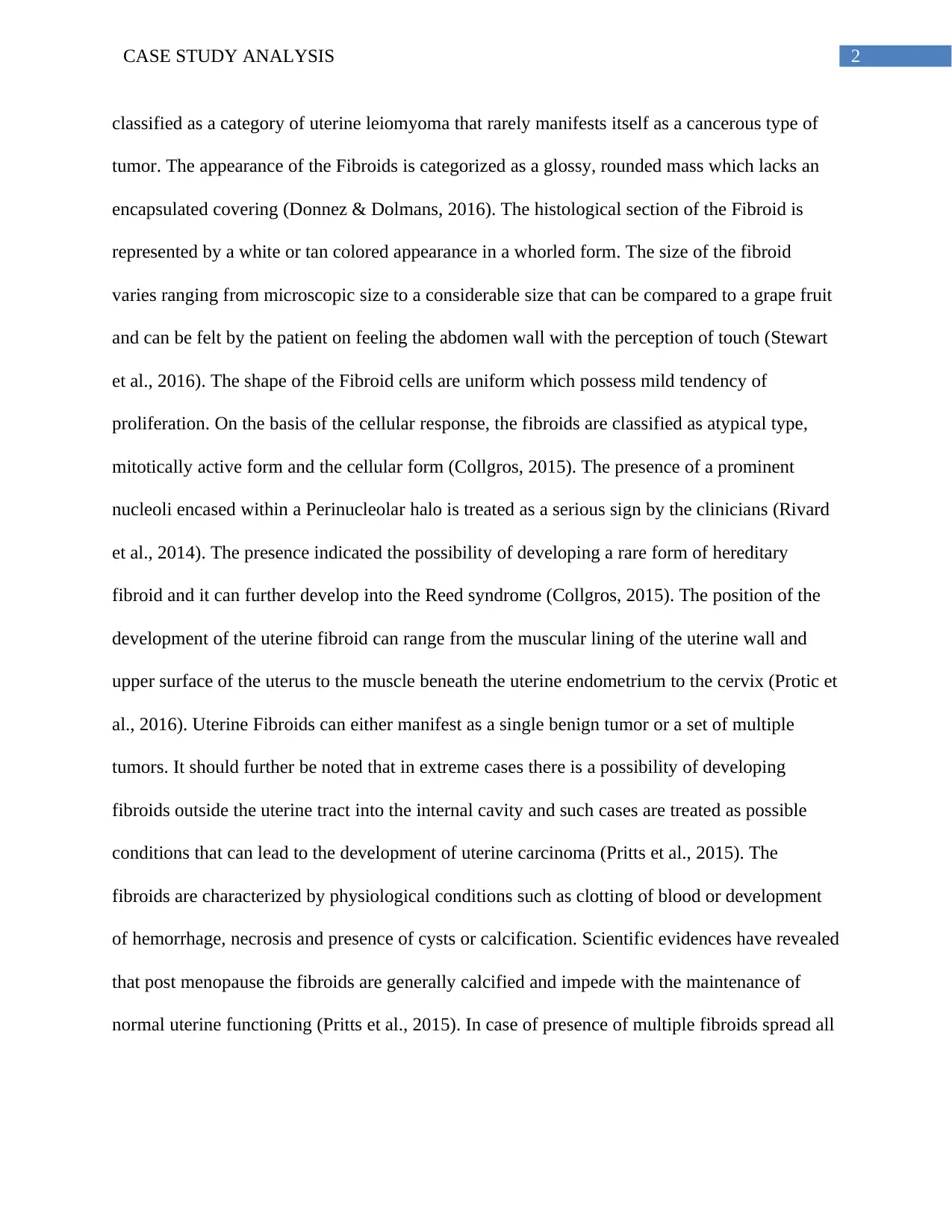
2CASE STUDY ANALYSIS
classified as a category of uterine leiomyoma that rarely manifests itself as a cancerous type of
tumor. The appearance of the Fibroids is categorized as a glossy, rounded mass which lacks an
encapsulated covering (Donnez & Dolmans, 2016). The histological section of the Fibroid is
represented by a white or tan colored appearance in a whorled form. The size of the fibroid
varies ranging from microscopic size to a considerable size that can be compared to a grape fruit
and can be felt by the patient on feeling the abdomen wall with the perception of touch (Stewart
et al., 2016). The shape of the Fibroid cells are uniform which possess mild tendency of
proliferation. On the basis of the cellular response, the fibroids are classified as atypical type,
mitotically active form and the cellular form (Collgros, 2015). The presence of a prominent
nucleoli encased within a Perinucleolar halo is treated as a serious sign by the clinicians (Rivard
et al., 2014). The presence indicated the possibility of developing a rare form of hereditary
fibroid and it can further develop into the Reed syndrome (Collgros, 2015). The position of the
development of the uterine fibroid can range from the muscular lining of the uterine wall and
upper surface of the uterus to the muscle beneath the uterine endometrium to the cervix (Protic et
al., 2016). Uterine Fibroids can either manifest as a single benign tumor or a set of multiple
tumors. It should further be noted that in extreme cases there is a possibility of developing
fibroids outside the uterine tract into the internal cavity and such cases are treated as possible
conditions that can lead to the development of uterine carcinoma (Pritts et al., 2015). The
fibroids are characterized by physiological conditions such as clotting of blood or development
of hemorrhage, necrosis and presence of cysts or calcification. Scientific evidences have revealed
that post menopause the fibroids are generally calcified and impede with the maintenance of
normal uterine functioning (Pritts et al., 2015). In case of presence of multiple fibroids spread all
classified as a category of uterine leiomyoma that rarely manifests itself as a cancerous type of
tumor. The appearance of the Fibroids is categorized as a glossy, rounded mass which lacks an
encapsulated covering (Donnez & Dolmans, 2016). The histological section of the Fibroid is
represented by a white or tan colored appearance in a whorled form. The size of the fibroid
varies ranging from microscopic size to a considerable size that can be compared to a grape fruit
and can be felt by the patient on feeling the abdomen wall with the perception of touch (Stewart
et al., 2016). The shape of the Fibroid cells are uniform which possess mild tendency of
proliferation. On the basis of the cellular response, the fibroids are classified as atypical type,
mitotically active form and the cellular form (Collgros, 2015). The presence of a prominent
nucleoli encased within a Perinucleolar halo is treated as a serious sign by the clinicians (Rivard
et al., 2014). The presence indicated the possibility of developing a rare form of hereditary
fibroid and it can further develop into the Reed syndrome (Collgros, 2015). The position of the
development of the uterine fibroid can range from the muscular lining of the uterine wall and
upper surface of the uterus to the muscle beneath the uterine endometrium to the cervix (Protic et
al., 2016). Uterine Fibroids can either manifest as a single benign tumor or a set of multiple
tumors. It should further be noted that in extreme cases there is a possibility of developing
fibroids outside the uterine tract into the internal cavity and such cases are treated as possible
conditions that can lead to the development of uterine carcinoma (Pritts et al., 2015). The
fibroids are characterized by physiological conditions such as clotting of blood or development
of hemorrhage, necrosis and presence of cysts or calcification. Scientific evidences have revealed
that post menopause the fibroids are generally calcified and impede with the maintenance of
normal uterine functioning (Pritts et al., 2015). In case of presence of multiple fibroids spread all
⊘ This is a preview!⊘
Do you want full access?
Subscribe today to unlock all pages.

Trusted by 1+ million students worldwide
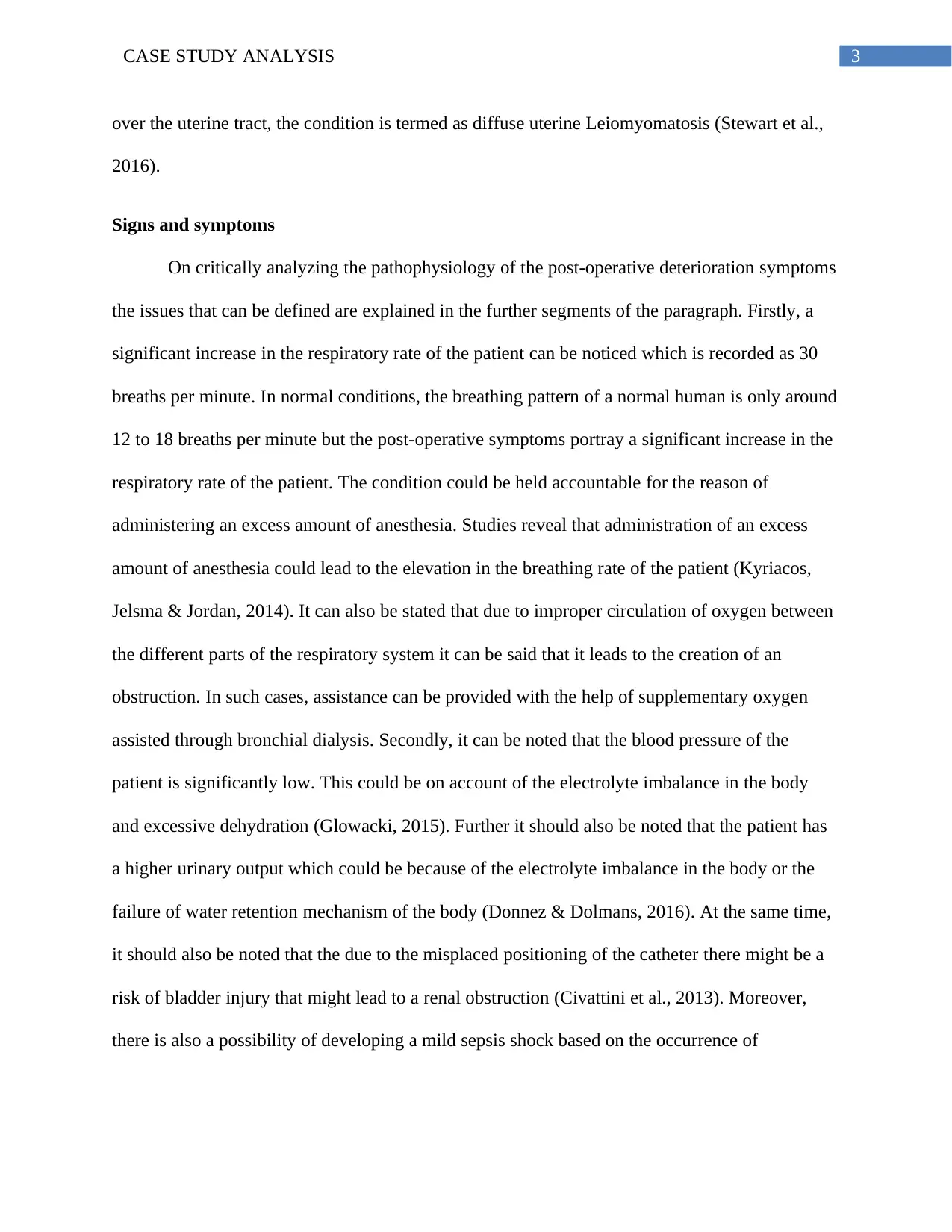
3CASE STUDY ANALYSIS
over the uterine tract, the condition is termed as diffuse uterine Leiomyomatosis (Stewart et al.,
2016).
Signs and symptoms
On critically analyzing the pathophysiology of the post-operative deterioration symptoms
the issues that can be defined are explained in the further segments of the paragraph. Firstly, a
significant increase in the respiratory rate of the patient can be noticed which is recorded as 30
breaths per minute. In normal conditions, the breathing pattern of a normal human is only around
12 to 18 breaths per minute but the post-operative symptoms portray a significant increase in the
respiratory rate of the patient. The condition could be held accountable for the reason of
administering an excess amount of anesthesia. Studies reveal that administration of an excess
amount of anesthesia could lead to the elevation in the breathing rate of the patient (Kyriacos,
Jelsma & Jordan, 2014). It can also be stated that due to improper circulation of oxygen between
the different parts of the respiratory system it can be said that it leads to the creation of an
obstruction. In such cases, assistance can be provided with the help of supplementary oxygen
assisted through bronchial dialysis. Secondly, it can be noted that the blood pressure of the
patient is significantly low. This could be on account of the electrolyte imbalance in the body
and excessive dehydration (Glowacki, 2015). Further it should also be noted that the patient has
a higher urinary output which could be because of the electrolyte imbalance in the body or the
failure of water retention mechanism of the body (Donnez & Dolmans, 2016). At the same time,
it should also be noted that the due to the misplaced positioning of the catheter there might be a
risk of bladder injury that might lead to a renal obstruction (Civattini et al., 2013). Moreover,
there is also a possibility of developing a mild sepsis shock based on the occurrence of
over the uterine tract, the condition is termed as diffuse uterine Leiomyomatosis (Stewart et al.,
2016).
Signs and symptoms
On critically analyzing the pathophysiology of the post-operative deterioration symptoms
the issues that can be defined are explained in the further segments of the paragraph. Firstly, a
significant increase in the respiratory rate of the patient can be noticed which is recorded as 30
breaths per minute. In normal conditions, the breathing pattern of a normal human is only around
12 to 18 breaths per minute but the post-operative symptoms portray a significant increase in the
respiratory rate of the patient. The condition could be held accountable for the reason of
administering an excess amount of anesthesia. Studies reveal that administration of an excess
amount of anesthesia could lead to the elevation in the breathing rate of the patient (Kyriacos,
Jelsma & Jordan, 2014). It can also be stated that due to improper circulation of oxygen between
the different parts of the respiratory system it can be said that it leads to the creation of an
obstruction. In such cases, assistance can be provided with the help of supplementary oxygen
assisted through bronchial dialysis. Secondly, it can be noted that the blood pressure of the
patient is significantly low. This could be on account of the electrolyte imbalance in the body
and excessive dehydration (Glowacki, 2015). Further it should also be noted that the patient has
a higher urinary output which could be because of the electrolyte imbalance in the body or the
failure of water retention mechanism of the body (Donnez & Dolmans, 2016). At the same time,
it should also be noted that the due to the misplaced positioning of the catheter there might be a
risk of bladder injury that might lead to a renal obstruction (Civattini et al., 2013). Moreover,
there is also a possibility of developing a mild sepsis shock based on the occurrence of
Paraphrase This Document
Need a fresh take? Get an instant paraphrase of this document with our AI Paraphraser
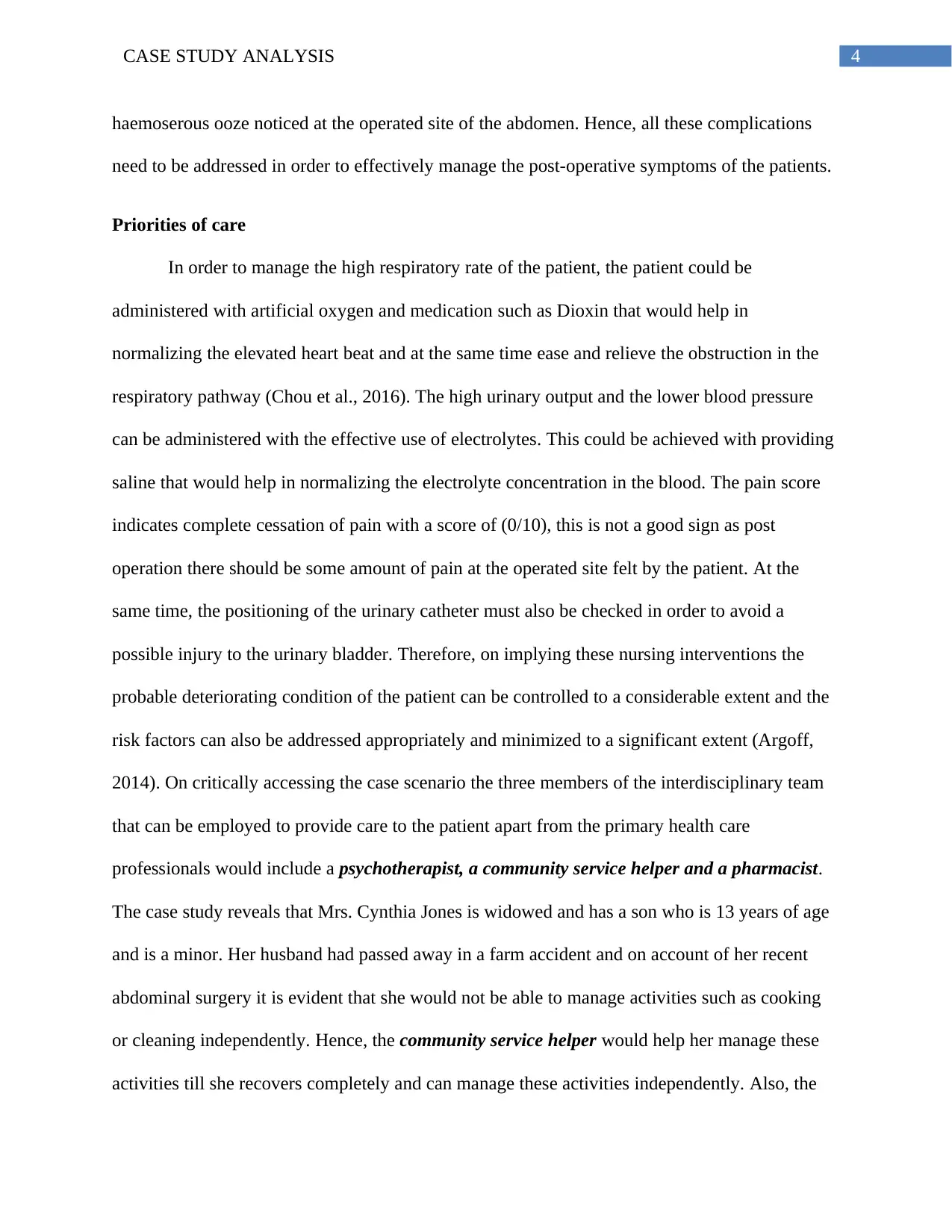
4CASE STUDY ANALYSIS
haemoserous ooze noticed at the operated site of the abdomen. Hence, all these complications
need to be addressed in order to effectively manage the post-operative symptoms of the patients.
Priorities of care
In order to manage the high respiratory rate of the patient, the patient could be
administered with artificial oxygen and medication such as Dioxin that would help in
normalizing the elevated heart beat and at the same time ease and relieve the obstruction in the
respiratory pathway (Chou et al., 2016). The high urinary output and the lower blood pressure
can be administered with the effective use of electrolytes. This could be achieved with providing
saline that would help in normalizing the electrolyte concentration in the blood. The pain score
indicates complete cessation of pain with a score of (0/10), this is not a good sign as post
operation there should be some amount of pain at the operated site felt by the patient. At the
same time, the positioning of the urinary catheter must also be checked in order to avoid a
possible injury to the urinary bladder. Therefore, on implying these nursing interventions the
probable deteriorating condition of the patient can be controlled to a considerable extent and the
risk factors can also be addressed appropriately and minimized to a significant extent (Argoff,
2014). On critically accessing the case scenario the three members of the interdisciplinary team
that can be employed to provide care to the patient apart from the primary health care
professionals would include a psychotherapist, a community service helper and a pharmacist.
The case study reveals that Mrs. Cynthia Jones is widowed and has a son who is 13 years of age
and is a minor. Her husband had passed away in a farm accident and on account of her recent
abdominal surgery it is evident that she would not be able to manage activities such as cooking
or cleaning independently. Hence, the community service helper would help her manage these
activities till she recovers completely and can manage these activities independently. Also, the
haemoserous ooze noticed at the operated site of the abdomen. Hence, all these complications
need to be addressed in order to effectively manage the post-operative symptoms of the patients.
Priorities of care
In order to manage the high respiratory rate of the patient, the patient could be
administered with artificial oxygen and medication such as Dioxin that would help in
normalizing the elevated heart beat and at the same time ease and relieve the obstruction in the
respiratory pathway (Chou et al., 2016). The high urinary output and the lower blood pressure
can be administered with the effective use of electrolytes. This could be achieved with providing
saline that would help in normalizing the electrolyte concentration in the blood. The pain score
indicates complete cessation of pain with a score of (0/10), this is not a good sign as post
operation there should be some amount of pain at the operated site felt by the patient. At the
same time, the positioning of the urinary catheter must also be checked in order to avoid a
possible injury to the urinary bladder. Therefore, on implying these nursing interventions the
probable deteriorating condition of the patient can be controlled to a considerable extent and the
risk factors can also be addressed appropriately and minimized to a significant extent (Argoff,
2014). On critically accessing the case scenario the three members of the interdisciplinary team
that can be employed to provide care to the patient apart from the primary health care
professionals would include a psychotherapist, a community service helper and a pharmacist.
The case study reveals that Mrs. Cynthia Jones is widowed and has a son who is 13 years of age
and is a minor. Her husband had passed away in a farm accident and on account of her recent
abdominal surgery it is evident that she would not be able to manage activities such as cooking
or cleaning independently. Hence, the community service helper would help her manage these
activities till she recovers completely and can manage these activities independently. Also, the
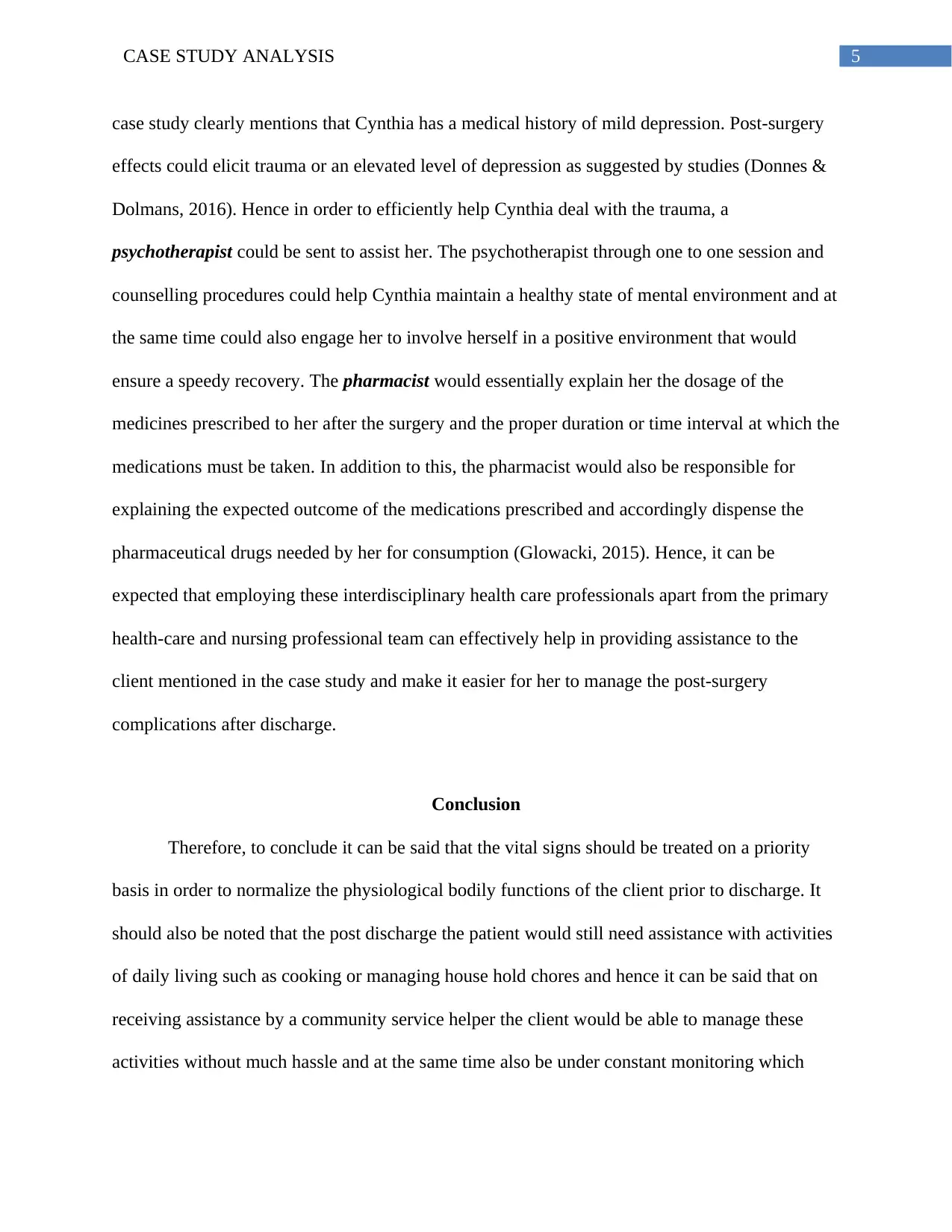
5CASE STUDY ANALYSIS
case study clearly mentions that Cynthia has a medical history of mild depression. Post-surgery
effects could elicit trauma or an elevated level of depression as suggested by studies (Donnes &
Dolmans, 2016). Hence in order to efficiently help Cynthia deal with the trauma, a
psychotherapist could be sent to assist her. The psychotherapist through one to one session and
counselling procedures could help Cynthia maintain a healthy state of mental environment and at
the same time could also engage her to involve herself in a positive environment that would
ensure a speedy recovery. The pharmacist would essentially explain her the dosage of the
medicines prescribed to her after the surgery and the proper duration or time interval at which the
medications must be taken. In addition to this, the pharmacist would also be responsible for
explaining the expected outcome of the medications prescribed and accordingly dispense the
pharmaceutical drugs needed by her for consumption (Glowacki, 2015). Hence, it can be
expected that employing these interdisciplinary health care professionals apart from the primary
health-care and nursing professional team can effectively help in providing assistance to the
client mentioned in the case study and make it easier for her to manage the post-surgery
complications after discharge.
Conclusion
Therefore, to conclude it can be said that the vital signs should be treated on a priority
basis in order to normalize the physiological bodily functions of the client prior to discharge. It
should also be noted that the post discharge the patient would still need assistance with activities
of daily living such as cooking or managing house hold chores and hence it can be said that on
receiving assistance by a community service helper the client would be able to manage these
activities without much hassle and at the same time also be under constant monitoring which
case study clearly mentions that Cynthia has a medical history of mild depression. Post-surgery
effects could elicit trauma or an elevated level of depression as suggested by studies (Donnes &
Dolmans, 2016). Hence in order to efficiently help Cynthia deal with the trauma, a
psychotherapist could be sent to assist her. The psychotherapist through one to one session and
counselling procedures could help Cynthia maintain a healthy state of mental environment and at
the same time could also engage her to involve herself in a positive environment that would
ensure a speedy recovery. The pharmacist would essentially explain her the dosage of the
medicines prescribed to her after the surgery and the proper duration or time interval at which the
medications must be taken. In addition to this, the pharmacist would also be responsible for
explaining the expected outcome of the medications prescribed and accordingly dispense the
pharmaceutical drugs needed by her for consumption (Glowacki, 2015). Hence, it can be
expected that employing these interdisciplinary health care professionals apart from the primary
health-care and nursing professional team can effectively help in providing assistance to the
client mentioned in the case study and make it easier for her to manage the post-surgery
complications after discharge.
Conclusion
Therefore, to conclude it can be said that the vital signs should be treated on a priority
basis in order to normalize the physiological bodily functions of the client prior to discharge. It
should also be noted that the post discharge the patient would still need assistance with activities
of daily living such as cooking or managing house hold chores and hence it can be said that on
receiving assistance by a community service helper the client would be able to manage these
activities without much hassle and at the same time also be under constant monitoring which
⊘ This is a preview!⊘
Do you want full access?
Subscribe today to unlock all pages.

Trusted by 1+ million students worldwide

6CASE STUDY ANALYSIS
would help in maintaining a track about the state of physiological deterioration or improvement
post-surgery.
would help in maintaining a track about the state of physiological deterioration or improvement
post-surgery.
Paraphrase This Document
Need a fresh take? Get an instant paraphrase of this document with our AI Paraphraser
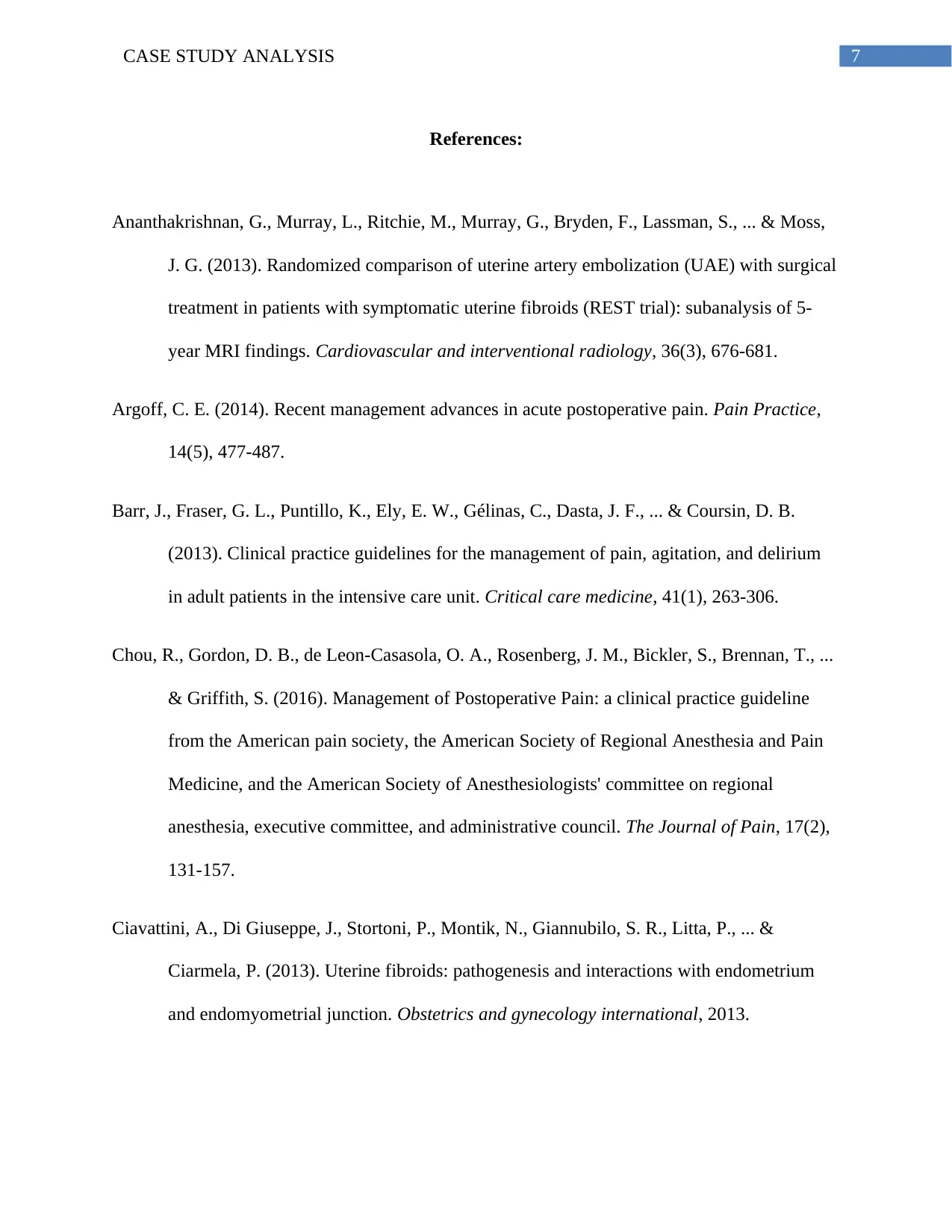
7CASE STUDY ANALYSIS
References:
Ananthakrishnan, G., Murray, L., Ritchie, M., Murray, G., Bryden, F., Lassman, S., ... & Moss,
J. G. (2013). Randomized comparison of uterine artery embolization (UAE) with surgical
treatment in patients with symptomatic uterine fibroids (REST trial): subanalysis of 5-
year MRI findings. Cardiovascular and interventional radiology, 36(3), 676-681.
Argoff, C. E. (2014). Recent management advances in acute postoperative pain. Pain Practice,
14(5), 477-487.
Barr, J., Fraser, G. L., Puntillo, K., Ely, E. W., Gélinas, C., Dasta, J. F., ... & Coursin, D. B.
(2013). Clinical practice guidelines for the management of pain, agitation, and delirium
in adult patients in the intensive care unit. Critical care medicine, 41(1), 263-306.
Chou, R., Gordon, D. B., de Leon-Casasola, O. A., Rosenberg, J. M., Bickler, S., Brennan, T., ...
& Griffith, S. (2016). Management of Postoperative Pain: a clinical practice guideline
from the American pain society, the American Society of Regional Anesthesia and Pain
Medicine, and the American Society of Anesthesiologists' committee on regional
anesthesia, executive committee, and administrative council. The Journal of Pain, 17(2),
131-157.
Ciavattini, A., Di Giuseppe, J., Stortoni, P., Montik, N., Giannubilo, S. R., Litta, P., ... &
Ciarmela, P. (2013). Uterine fibroids: pathogenesis and interactions with endometrium
and endomyometrial junction. Obstetrics and gynecology international, 2013.
References:
Ananthakrishnan, G., Murray, L., Ritchie, M., Murray, G., Bryden, F., Lassman, S., ... & Moss,
J. G. (2013). Randomized comparison of uterine artery embolization (UAE) with surgical
treatment in patients with symptomatic uterine fibroids (REST trial): subanalysis of 5-
year MRI findings. Cardiovascular and interventional radiology, 36(3), 676-681.
Argoff, C. E. (2014). Recent management advances in acute postoperative pain. Pain Practice,
14(5), 477-487.
Barr, J., Fraser, G. L., Puntillo, K., Ely, E. W., Gélinas, C., Dasta, J. F., ... & Coursin, D. B.
(2013). Clinical practice guidelines for the management of pain, agitation, and delirium
in adult patients in the intensive care unit. Critical care medicine, 41(1), 263-306.
Chou, R., Gordon, D. B., de Leon-Casasola, O. A., Rosenberg, J. M., Bickler, S., Brennan, T., ...
& Griffith, S. (2016). Management of Postoperative Pain: a clinical practice guideline
from the American pain society, the American Society of Regional Anesthesia and Pain
Medicine, and the American Society of Anesthesiologists' committee on regional
anesthesia, executive committee, and administrative council. The Journal of Pain, 17(2),
131-157.
Ciavattini, A., Di Giuseppe, J., Stortoni, P., Montik, N., Giannubilo, S. R., Litta, P., ... &
Ciarmela, P. (2013). Uterine fibroids: pathogenesis and interactions with endometrium
and endomyometrial junction. Obstetrics and gynecology international, 2013.
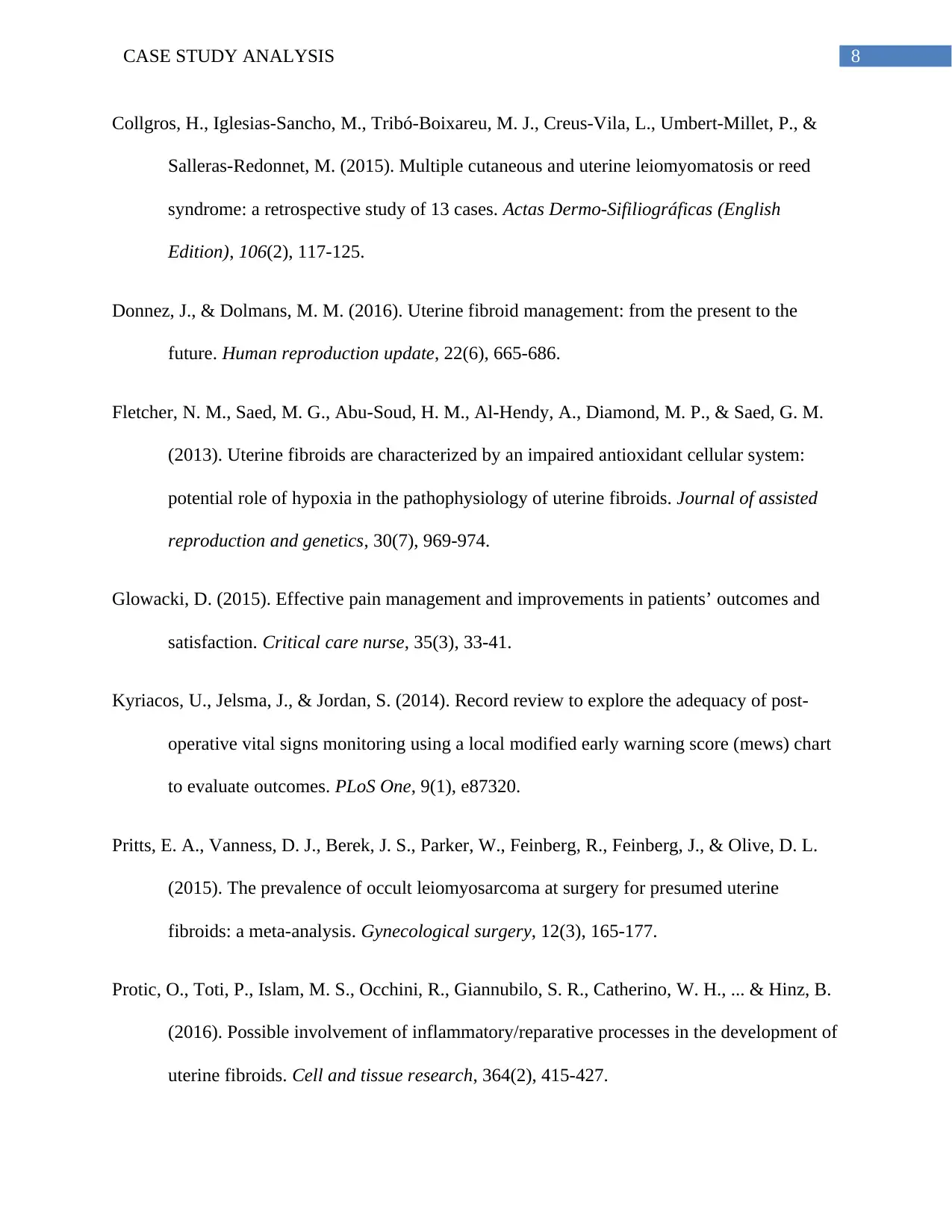
8CASE STUDY ANALYSIS
Collgros, H., Iglesias-Sancho, M., Tribó-Boixareu, M. J., Creus-Vila, L., Umbert-Millet, P., &
Salleras-Redonnet, M. (2015). Multiple cutaneous and uterine leiomyomatosis or reed
syndrome: a retrospective study of 13 cases. Actas Dermo-Sifiliográficas (English
Edition), 106(2), 117-125.
Donnez, J., & Dolmans, M. M. (2016). Uterine fibroid management: from the present to the
future. Human reproduction update, 22(6), 665-686.
Fletcher, N. M., Saed, M. G., Abu-Soud, H. M., Al-Hendy, A., Diamond, M. P., & Saed, G. M.
(2013). Uterine fibroids are characterized by an impaired antioxidant cellular system:
potential role of hypoxia in the pathophysiology of uterine fibroids. Journal of assisted
reproduction and genetics, 30(7), 969-974.
Glowacki, D. (2015). Effective pain management and improvements in patients’ outcomes and
satisfaction. Critical care nurse, 35(3), 33-41.
Kyriacos, U., Jelsma, J., & Jordan, S. (2014). Record review to explore the adequacy of post-
operative vital signs monitoring using a local modified early warning score (mews) chart
to evaluate outcomes. PLoS One, 9(1), e87320.
Pritts, E. A., Vanness, D. J., Berek, J. S., Parker, W., Feinberg, R., Feinberg, J., & Olive, D. L.
(2015). The prevalence of occult leiomyosarcoma at surgery for presumed uterine
fibroids: a meta-analysis. Gynecological surgery, 12(3), 165-177.
Protic, O., Toti, P., Islam, M. S., Occhini, R., Giannubilo, S. R., Catherino, W. H., ... & Hinz, B.
(2016). Possible involvement of inflammatory/reparative processes in the development of
uterine fibroids. Cell and tissue research, 364(2), 415-427.
Collgros, H., Iglesias-Sancho, M., Tribó-Boixareu, M. J., Creus-Vila, L., Umbert-Millet, P., &
Salleras-Redonnet, M. (2015). Multiple cutaneous and uterine leiomyomatosis or reed
syndrome: a retrospective study of 13 cases. Actas Dermo-Sifiliográficas (English
Edition), 106(2), 117-125.
Donnez, J., & Dolmans, M. M. (2016). Uterine fibroid management: from the present to the
future. Human reproduction update, 22(6), 665-686.
Fletcher, N. M., Saed, M. G., Abu-Soud, H. M., Al-Hendy, A., Diamond, M. P., & Saed, G. M.
(2013). Uterine fibroids are characterized by an impaired antioxidant cellular system:
potential role of hypoxia in the pathophysiology of uterine fibroids. Journal of assisted
reproduction and genetics, 30(7), 969-974.
Glowacki, D. (2015). Effective pain management and improvements in patients’ outcomes and
satisfaction. Critical care nurse, 35(3), 33-41.
Kyriacos, U., Jelsma, J., & Jordan, S. (2014). Record review to explore the adequacy of post-
operative vital signs monitoring using a local modified early warning score (mews) chart
to evaluate outcomes. PLoS One, 9(1), e87320.
Pritts, E. A., Vanness, D. J., Berek, J. S., Parker, W., Feinberg, R., Feinberg, J., & Olive, D. L.
(2015). The prevalence of occult leiomyosarcoma at surgery for presumed uterine
fibroids: a meta-analysis. Gynecological surgery, 12(3), 165-177.
Protic, O., Toti, P., Islam, M. S., Occhini, R., Giannubilo, S. R., Catherino, W. H., ... & Hinz, B.
(2016). Possible involvement of inflammatory/reparative processes in the development of
uterine fibroids. Cell and tissue research, 364(2), 415-427.
⊘ This is a preview!⊘
Do you want full access?
Subscribe today to unlock all pages.

Trusted by 1+ million students worldwide
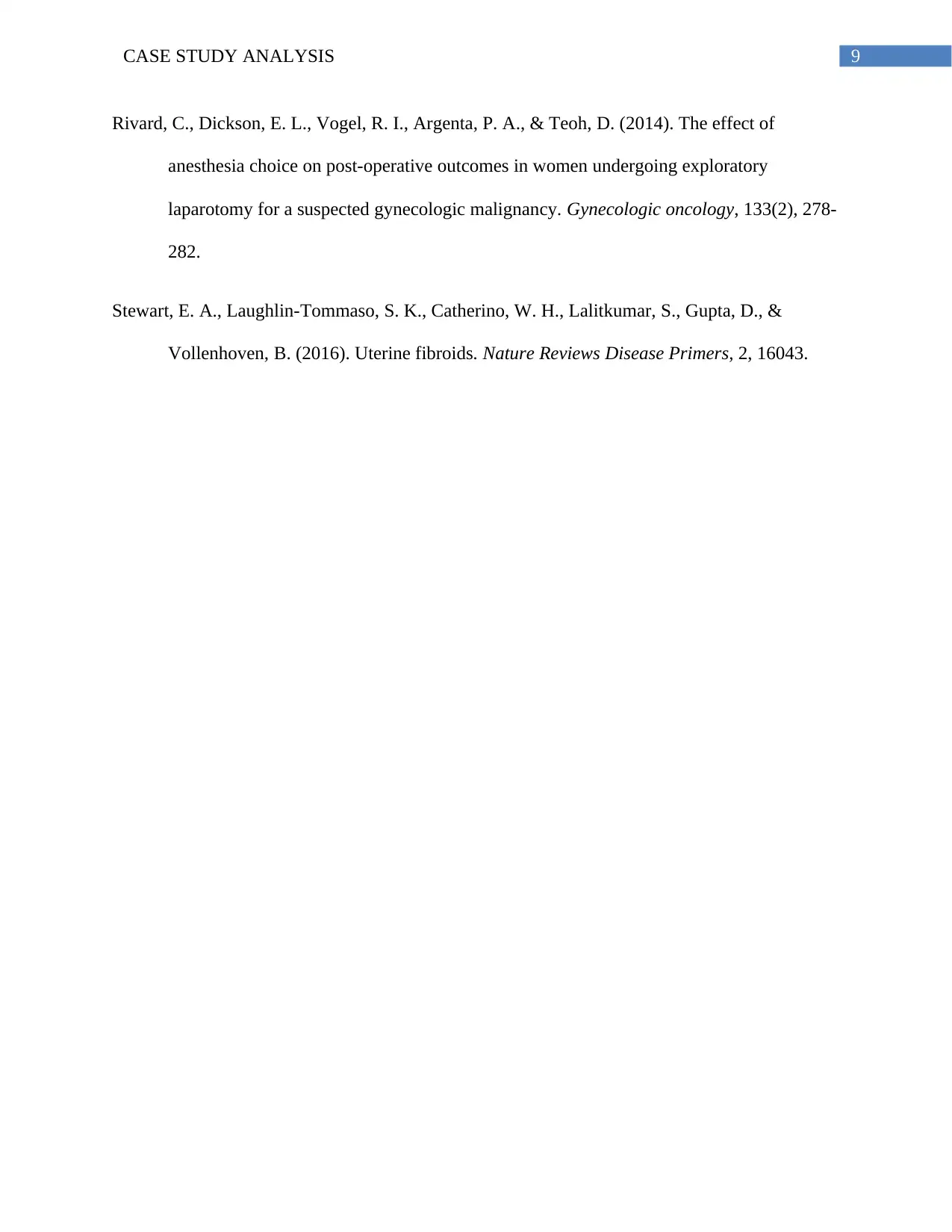
9CASE STUDY ANALYSIS
Rivard, C., Dickson, E. L., Vogel, R. I., Argenta, P. A., & Teoh, D. (2014). The effect of
anesthesia choice on post-operative outcomes in women undergoing exploratory
laparotomy for a suspected gynecologic malignancy. Gynecologic oncology, 133(2), 278-
282.
Stewart, E. A., Laughlin-Tommaso, S. K., Catherino, W. H., Lalitkumar, S., Gupta, D., &
Vollenhoven, B. (2016). Uterine fibroids. Nature Reviews Disease Primers, 2, 16043.
Rivard, C., Dickson, E. L., Vogel, R. I., Argenta, P. A., & Teoh, D. (2014). The effect of
anesthesia choice on post-operative outcomes in women undergoing exploratory
laparotomy for a suspected gynecologic malignancy. Gynecologic oncology, 133(2), 278-
282.
Stewart, E. A., Laughlin-Tommaso, S. K., Catherino, W. H., Lalitkumar, S., Gupta, D., &
Vollenhoven, B. (2016). Uterine fibroids. Nature Reviews Disease Primers, 2, 16043.
1 out of 10
Related Documents
Your All-in-One AI-Powered Toolkit for Academic Success.
+13062052269
info@desklib.com
Available 24*7 on WhatsApp / Email
![[object Object]](/_next/static/media/star-bottom.7253800d.svg)
Unlock your academic potential
Copyright © 2020–2025 A2Z Services. All Rights Reserved. Developed and managed by ZUCOL.





